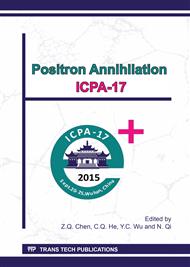[1]
A. Zielinski, S. Sobieszczyk, International journal of hydrogen energy 36 (2011) 8961-8629.
Google Scholar
[2]
M. B. Lewis, Deuterium-defect trapping in ion-irradiated zirconium, J. Nucl. Mater. 125 (1984) 152-159.
DOI: 10.1016/0022-3115(84)90542-7
Google Scholar
[3]
Y. S. Bordulev, R. S. Laptev, V. N. Kudiyarov, A. M. Lider, Investigation of Commercially Pure Titanium Structure during Accumulation and Release of Hydrogen by Means of Positron Lifetime and Electrical Resitivity Measurements, Advanced Materials Research 880 (2014).
DOI: 10.4028/www.scientific.net/amr.880.93
Google Scholar
[4]
R. Laptev, A. Lider, Yu. Bordulev, V. Kudiiarov, G. Garanin, Hydrogen-induced microstructure changes in titanium, J. Alloys Compd. 645 (2015) 193-195.
DOI: 10.1016/j.jallcom.2014.12.257
Google Scholar
[5]
Y. Fukai, N. Okuma, Phys. Rev. Lett. 73 (1994) 1640–1643.
Google Scholar
[6]
Y. Shirai, H. Araki, T. Mori, W. Nakamura, K. Sakaki, J. Alloys Compd. 330 (2002) 125-131.
Google Scholar
[7]
J. Cizek, I. Prochazka, S. Danis, M. Cieslar, G. Brauer, W. Anwand, R. Kirchheim, A. Pundt, Journal of Alloys and Compounds. 446-447 (2007) 479-483.
DOI: 10.1016/j.jallcom.2006.11.105
Google Scholar
[8]
J. Cizek, I. Prochazka, F. Becvar, R. Kuzel, M. Cieslar, G. Brauer, W. Anwand, R. Kirchheim, A. Pundt, Physical Review. B 69 224106 (2004).
Google Scholar
[9]
R. S. Laptev, A. M. Lider, Y. S. Bordulev, V. N. Kudiyarov, G. V. Garanin, W. Wang, P. V. Kuznetsov, Investigation of Defects in Hydrogen-Saturated Titanium by Means of Positron Annihilation Techniques, Defect and Diffusion Forum 365 (2015).
DOI: 10.4028/www.scientific.net/ddf.365.232
Google Scholar
[10]
R. S. Laptev, Y. S. Bordulev, V. N. Kudiyarov, A. M. Lider, G. V. Garanin, Positron Annihilation Spectroscopy of Defects in Commercially Pure Titanium Saturated with Hydrogen, Advanced Materials Research 880 (2014) 134-140.
DOI: 10.4028/www.scientific.net/amr.880.134
Google Scholar
[11]
R. Krause-Rehberg, H.S. Leipner. Positron Annihilation in Semiconductors: Defect Studies, third ed., Berlin Heidelberg, New York (2003).
Google Scholar
[12]
A. Dupasquier, A.P. Mills: Proceedings International School of Physics Enrico Fermi, Course, CXXV. (1995).
Google Scholar
[13]
Y. Chen, X. Wan, F. Li et al., Materials Science and Engineering: A. 466 (2007) 156–159.
Google Scholar
[14]
V.N. Kudiiarov, L.V. Gulidova, N.S. Pushilina, A.M. Lider, Advanced Materials Research 740 (2013) 690-693.
DOI: 10.4028/www.scientific.net/amr.740.690
Google Scholar
[15]
A. A. Shmakov, The absorption of hydrogen by fuel claddings of light water reactors, Scientific session of MEPhI 13 (1999), 129-131.
Google Scholar
[16]
A. S. Zaymovsiy, A. V. Nikulina, N. G. Reshetnikov, Zirconium alloys in nuclear power engineering, Energomizdat, Moscow, (1994).
Google Scholar
[17]
A. A. Shmakov, E.A. Smirnov, H. Bruhertzoifer, Distribution and diffusion of hydrogen in the oxidized zirconium-based alloys, Atomic Energy (1998).
DOI: 10.1007/bf02359343
Google Scholar
[18]
D. Giebel, J. Kansy, Materials Science Forum 666 (2010) 138-141.
Google Scholar
[19]
I.K. MacKenzie, in: W. Brandt, A. Dupasquier (Eds. ), Positron Solid-State Physics, North Holland, Amsterdam, (1995).
Google Scholar
[20]
G. J. Thomas, W. D. Drotning, Hydrogen Induced Lattice Expansion in Nickel, Metallurgical Transactions A 14A (1983) 1547.
Google Scholar
[21]
R.A. Oriani, The Physical and Metallurgical Aspects of Hydrogen in Metals, in ICCF4, Fourth International Conference on Cold Fusion, (1993).
Google Scholar
[22]
J. M. Campillo, F. Plazaola and N. Diego, J. Phys.: Condens. Matter 12 (2000) 9715.
Google Scholar
[23]
H. E. Hansen, R. M. Nieminen, M.J. Puska, J. Phys. F 14 (1984) 1299 – 1316.
Google Scholar


